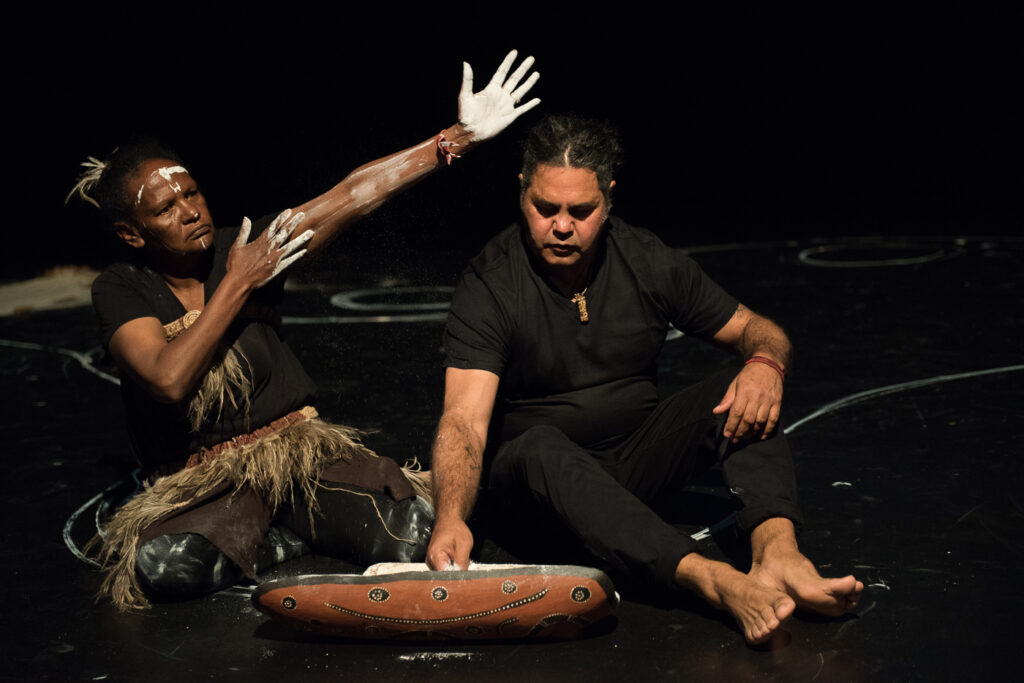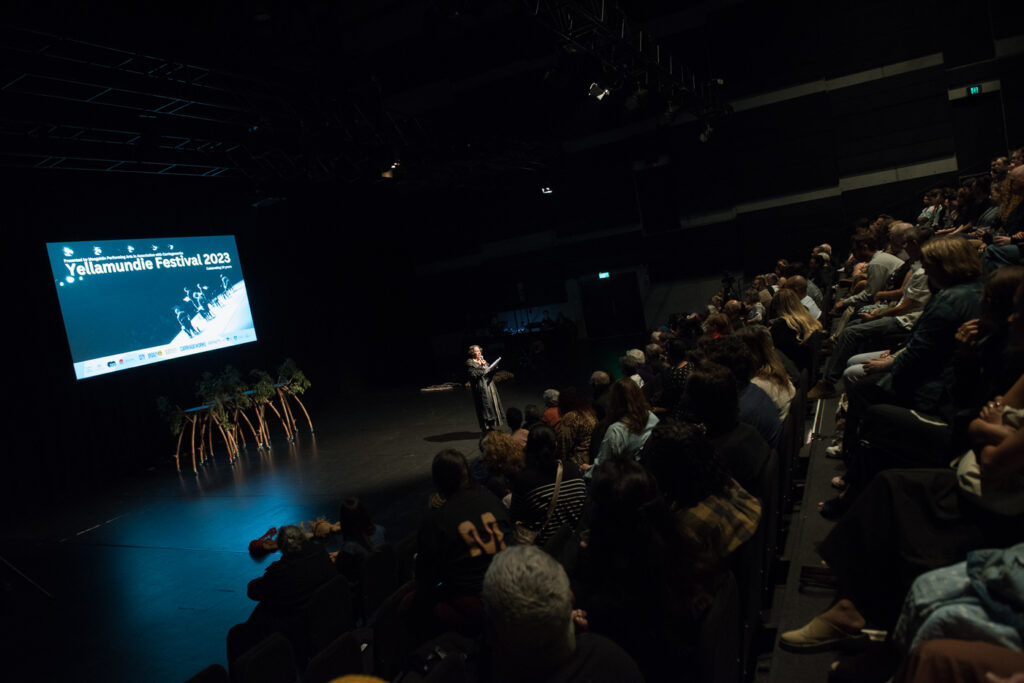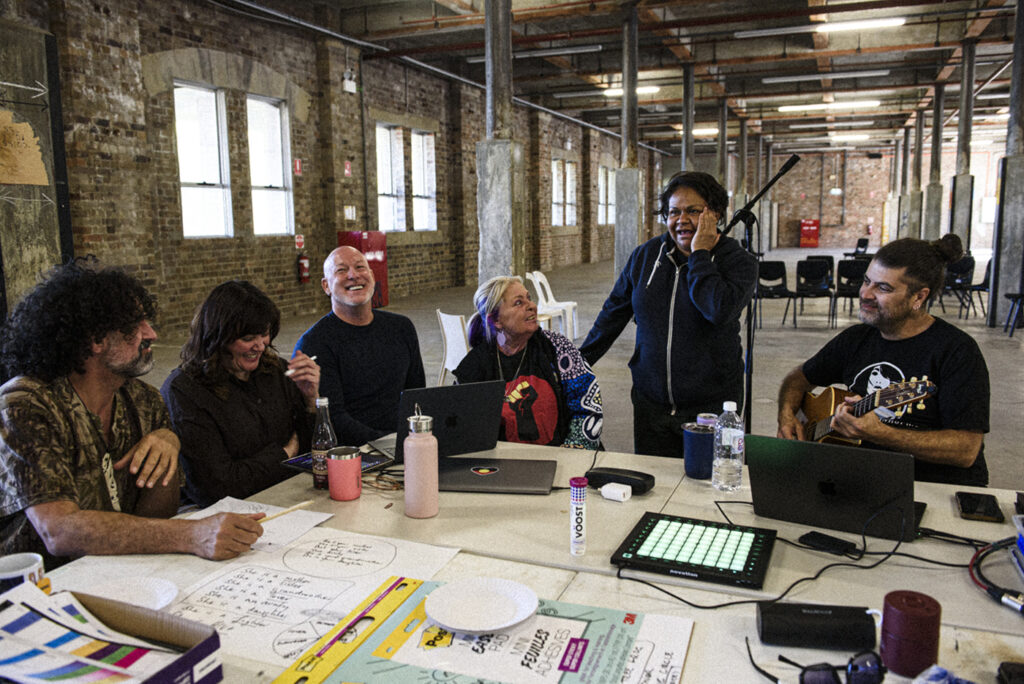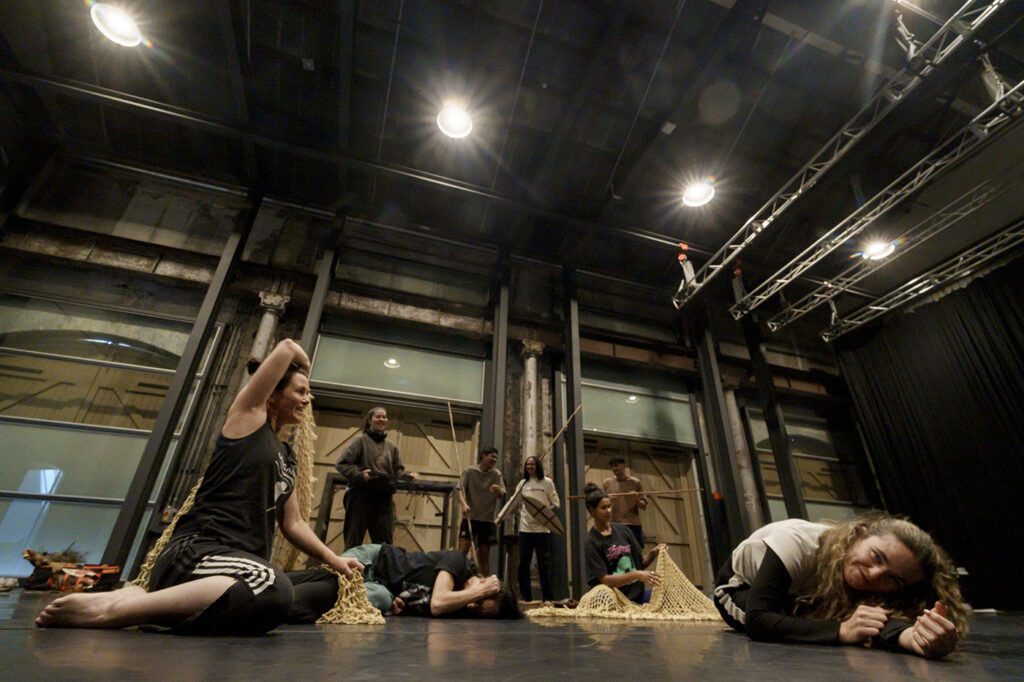Creative Profile: Moogahlin Performing Arts
Moogahlin Performing Arts is NSW’s leading First Peoples performing arts company based on Gadigal at Carriageworks, and on Ngemba land in Brewarrina, far-west NSW. It develops, produces, and presents new work, is strongly connected to community, and is committed to nurturing multiple generations of First Peoples arts practitioners locally, nationally, and internationally. Moogahlin was formed in Redfern in 2007 in honour of the late Kevin Smith’s request and in memory of the founding members of the National Black Theatre. It was established by a group of First Peoples performance artists, educators and community workers and has adopted a peer-based artistic directorship model based on cultural principles. It provides a supportive, yet critical and interrogative framework for the discussion and development of new performance work.
Lily Shearer, Artistic Director and Co-Founder of Moogahlin Performing Arts chats with Tamara Winikoff.
There has been a proliferation of urban based First Peoples arts and cultural groups established since the 1970s. Where does Moogahlin fit in this picture?
We’ve been in the local area since our beginning and at Carriageworks since 2014. Nationally, we sit alongside our cousin companies as a collective of First Nations Performing Arts: Ilbijerri, Yirra Yaakin, BlakDance, Bangarra, Marrugeku and NAISDA. Together, we’ve developed the First Nations Performing Arts Workforce Development Framework 2025-2030, which outlines a strategy to transform how we recruit, train and retain a culturally strong and sustainable First Nations workforce in our sector.
Moogahlin’s Yellamundie Festival, started in 2013, is the only program of its kind, selecting new works from a national callout every two years. We support those creatives with two weeks of intensive development alongside expert directors and dramaturgs, and showcase the works-in-development, over three nights.
Through this program, Moogahlin has supported 44 new works, with 18 of those (so far) going on to full stage production by various companies. We’re very proud that Moogahlin has grown to have such a broad impact across Australian theatre.

Does Moogahlin aim to carry on the traditions of the National Black Theatre (1972 to 1977) which grew out of political struggles?
All our stories are political. Sometimes that’s fierce, sometimes it’s gentle. But we’re always talking about resistance and resilience. And we’re always connected to land and country, which in itself is political because of the history of this place. We carry these things into our work every day.
What methods do you use to foster a culturally empowered First Peoples performing arts sector to be strong in body, heart, mind, and spirit.
We live our values: respect; responsibility; relationships; reciprocity; relevance.
Our leadership role means we have responsibility to create opportunities, give voice to those who have none, create culturally safe spaces, and contribute to legacy around storytelling and knowledge-sharing.
We develop cultural arts exchange with community and artists locally, nationally and internationally, engaging in critical discourse from a First Peoples world view.

Photo Jamie James
How do your efforts in the areas of performance, education and community development complement each other?
Our three major platforms build First Peoples skills, deliver performance, and develop community.
As well as Yellamundie Festival, we have:
- Baiame’s Ngunnhu (Creator’s Fish Traps) Festival, which happens on Ngemba country, Brewarrina in far-northwest NSW. It’s our remote community cultural development gathering, over 2 to 3 days;
- Koori Gras Divas, our qweer program since 2017, which was part of Sydney World Pride in 2023, and has been presented in Brewarrina since 2024.
Together, these programs serve our vision of transformation through cultural arts. They support First Peoples performing arts practitioners, empower our communities and provide sector leadership.
What is the relationship between the work you do in Brewarrina and Sydney?
All our work is interconnected. Our artistic and production teams work across projects and places. We’re working in Brewarrina on a beautiful Muruwari story Ngapa Mayi Purtu, which will be presented there as an installation with performative elements, and then tour regionally, to the city, and hopefully to Aotearoa.
We’ve taken Koori Gras Divas from Sydney to Brewarrina to give agency to our rainbow family in remote NSW because they haven’t had a platform for performance. Next year, we’ll go deeper, with workshops in the lead-up to the big cabaret night.
In your work, how do you balance respect for tradition and critical innovation?
That’s easy. Our culture evolved BC (before Cook) and continues to evolve AC (after Cook). Tradition and cultural innovation are not separate things; it is part of our tradition to be innovative. Whether that’s in form, or the story itself, culture is always evolving, alongside adhering to cultural protocols of the place that we are telling the story from so we give agency to the people of those lands.
Has the interest of audiences changed since Moogahlin was established? If so, how?
Absolutely. Our priority target is our First Peoples communities, and we’ve grown to also bring First Peoples stories to wider audiences. Originally, Yellamundie Festival was exclusive to playwriting. Now, it also encompasses dance and physical theatre, music and composition; even poetry. Storytellers want to communicate in multidisciplinary, interdisciplinary ways, and audiences are responding to it and then seeking it out. In 2025, Yellamundie Festival genre-defying works include Luke Currie-Richardson’s Diary of a City Blak and Jacob Boehme’s Imigo.

Photo Jamie James and Jarrahmindi Bill
Since Moogahlin’s first community development performance project, ‘Gathering Ground’ in 2010 at the Block in Redfern Sydney, the program has grown to include three key festivals as well as several new artist and sector development initiatives. Can you tell us about all that?
Moogahlin is committed to building the capability of Blak creatives and the sector. We partner with many First Peoples and other organisations, and participate in national and international sector gatherings. This year we presented a Yellamundie Festival retrospective at the Yirramboi in Narrm, and an overview of First Peoples works at Arts on Tours’ Salon.
We do cross-cultural collaborations and developments, for example with the Aanmitaagzi company based in Nipissing, Turtle Island (Canada), who came to Brewarrina to co-create and present a beautiful new work, Serpent Water Stories.
A very important part of our commitment is to training young and other emerging practitioners. Wherever funding allows, we create Associate and Intern roles for directors, designers, producers and production specialists.

You are evidently developing expanding platforms to share your stories with the world. Where do you aim to go next?
Our first big international presentation is in New York City in January 2026, where The Visitors by Jane Harrison, is being presented at the new Perelman Performing Arts Center. We’ve had huge interest in The Visitors from overseas, and are developing more international touring for it. We’re also hoping to have an Ice Follies collaboration with Aanmitaagzi, in Nipissing in 2027.
There’s so much to keep us busy and excited at Moogahlin!
Media contact:
Gina Machado, General Manager, Moogahlin Performing Arts | gm@moogahlin.org 0455 472 618
Article by Tamara Winikoff
Tamara Winikoff is an independent consultant with extensive experience in arts advocacy, policy, and cultural leadership. She was a a founding member of the Inner West Creative Network and served as Executive Director of the National Association for the Visual Arts (NAVA) for 22 years, championing artists' rights and sector development. As Co-convenor of ArtsPeak, she coordinated national arts policy initiatives. Previously, she managed the Community, Environment, Art and Design (CEAD) program at the Australia Council for the Arts and lectured in Cultural Environment and Heritage at Macquarie University. Based in Sydney, she continues to influence the cultural landscape through strategic consultancy.
